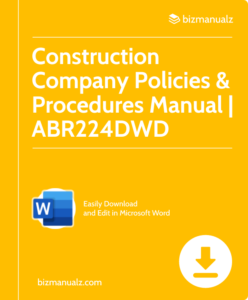What Are Key Performance Metrics KPIs for Construction?

Are you struggling to measure the success of your construction projects? Look no further. In this article, you will discover the vital performance metrics that will help you accurately gauge the efficiency and effectiveness of your construction operations. Say goodbye to uncertainty and hello to data-driven decision making. What Are Key Performance Metrics KPIs for Construction?
What Are Key Performance Metrics for Construction?
Key performance metrics play a crucial role in measuring the success of construction projects. They serve as a means to track progress, identify areas for improvement, and ensure project goals are met. Some important key performance metrics for construction include:
- Schedule adherence: This involves monitoring if projects are completed within the specified timeframe.
- Cost variance: This metric compares actual project costs to budgeted costs.
- Quality control: This metric assesses the quality of workmanship and materials used.
- Safety records: This metric tracks incidents and promotes a safe working environment.
Pro-tip: Regularly analyzing and reviewing key performance metrics can greatly benefit construction companies by providing valuable insights and helping to improve overall project performance.
Why Are Key Performance Metrics Important in Construction?
The importance of key performance metrics in construction cannot be overstated. These metrics provide crucial quantitative data that allows project managers to evaluate performance, identify areas for improvement, and make well-informed decisions. They measure various aspects of a project, including progress, cost efficiency, quality, and safety.
By closely monitoring these metrics, construction companies can identify bottlenecks, effectively manage resources, and ensure timely and budget-friendly completion of projects. Furthermore, these metrics serve as a benchmark for assessing the success of a project and can guide efforts towards continuous improvement. Ultimately, incorporating key performance metrics is crucial for optimizing construction processes and achieving overall project success.
How Are Key Performance Metrics Measured in Construction?
In the construction industry, measuring performance is crucial for ensuring successful project completion. Key performance metrics serve as valuable tools for tracking progress and identifying areas for improvement. In this section, we will discuss the various methods of measuring key performance metrics in construction, including the Schedule Performance Index (SPI), Cost Performance Index (CPI), Earned Value (EV), and Return on Investment (ROI). Each of these metrics provides unique insights into the efficiency and effectiveness of a construction project.
1. Schedule Performance Index
The Schedule Performance Index (SPI) is a crucial performance metric in construction that evaluates the efficiency of a project’s schedule performance.
- To calculate the SPI, divide the earned value (EV) by the planned value (PV).
- A project with an SPI of 1 is on schedule, while an SPI less than 1 indicates that the project is behind schedule.
- An SPI greater than 1 signifies that the project is ahead of schedule.
- Regularly monitoring the SPI is essential in identifying any deviations from the planned schedule and taking corrective actions if necessary.
- To improve the SPI, optimize resource allocation, ensure timely procurement of materials, and effectively manage subcontractors.
To enhance schedule performance, construction companies should prioritize effective project planning, utilize project management software, and maintain open communication with all stakeholders.
2. Cost Performance Index
To measure the cost performance index (CPI) in construction, follow these steps:
- Calculate the earned value (EV) by multiplying the percentage of work completed by the budgeted cost of work scheduled.
- Calculate the actual cost (AC) by summing up all the costs incurred during the project.
- Divide EV by AC to obtain the Cost Performance Index (CPI). A CPI value below 1 indicates cost overruns, while a value above 1 suggests cost savings.
To improve cost performance metrics in construction:
- Accurately estimate costs before the project starts.
- Regularly track and monitor actual costs against the budget.
- Implement effective cost control measures.
- Identify and address cost variances promptly.
3. Earned Value
Earned Value (EV) is a crucial performance metric in construction used to assess project progress and budget performance. To calculate EV, follow these steps:
- Define the project scope and establish a baseline budget.
- Track the actual costs incurred during the project.
- Determine the percentage of completion for each project task.
- Multiply the percentage of completion by the budgeted cost for each task to calculate the planned value (PV).
- Compare the PV to the actual costs incurred to calculate the EV.
- Assess the variance between EV and PV to determine if the project is ahead or behind schedule and if it is over or under budget.
By regularly monitoring and analyzing EV, construction companies can make informed decisions to ensure project success and profitability.
4. Return on Investment
Return on Investment (ROI) is an essential metric for construction companies to measure their performance. It evaluates the profitability of an investment by comparing the net profit to the initial investment. A higher ROI signifies a more profitable project or investment.
To calculate ROI, construction companies can divide the net profit by the initial investment and multiply it by 100 to get a percentage. This metric assists companies in making informed decisions about project feasibility and allocation of resources. By prioritizing the maximization of ROI, construction companies can guarantee efficient project management and financial prosperity.
What Are the Top Key Performance Metrics for Construction Companies?
In the construction industry, measuring and monitoring performance is crucial for the success of a company. There are several key performance metrics that construction companies use to track their progress and identify areas for improvement. In this section, we will discuss the top key performance metrics for construction companies, including labor productivity, safety performance, quality performance, equipment utilization, and project profitability. By understanding these metrics, construction companies can better assess their overall performance and make strategic decisions for future projects.
1. Labor Productivity
Labor productivity is an essential key performance indicator in the construction industry. To enhance labor productivity, construction companies can implement the following strategies:
- Invest in training and development programs to improve skills and knowledge.
- Implement efficient scheduling and project planning to optimize workflow.
- Provide a safe and ergonomic work environment to minimize downtime.
- Utilize technology and automation to streamline processes and reduce manual labor.
- Ensure effective communication and collaboration among team members.
3. Quality Performance
Quality performance is a crucial key performance metric in construction that assesses the level of excellence and adherence to standards in construction projects. To improve quality performance, construction companies can take the following steps:
- Establish quality control processes to ensure that materials and workmanship meet specified requirements and maintain high quality performance.
- Train and educate workers on quality standards and procedures to ensure they understand and can execute tasks to meet those standards and continuously improve quality performance.
- Regularly inspect and test materials and work in progress to identify any deviations from quality standards and take corrective action to maintain high quality performance.
- Implement a feedback loop with clients and stakeholders to gather feedback on the quality of completed projects and use it to drive improvement and maintain high quality performance.
- Continuously monitor and evaluate quality performance metrics to identify trends and areas for improvement and maintain high quality performance.
True story: XYZ Construction implemented a rigorous quality control program, resulting in a significant decrease in rework and increased client satisfaction. By investing in training and inspections, they achieved a reputation for delivering high-quality projects on time and within budget, maintaining high quality performance.
4. Equipment Utilization
To improve efficiency in construction projects, it is essential to focus on equipment utilization. Here are the key steps to enhance equipment utilization in construction:
- Analyze equipment needs: Evaluate project requirements and determine the necessary types and quantities of equipment.
- Plan equipment schedules: Develop a detailed schedule to ensure proper allocation and coordination of equipment across various tasks.
- Implement preventive maintenance: Regularly maintain equipment to minimize breakdowns and downtime.
- Train operators: Ensure operators are trained effectively to maximize equipment efficiency and minimize errors.
- Monitor utilization metrics: Keep track of equipment utilization metrics, such as downtime and idle time, to identify areas for improvement.
By following these steps, construction companies can improve equipment utilization, resulting in increased productivity and cost savings.
5. Project Profitability
Project profitability is a crucial key performance metric for construction companies. To improve project profitability, construction companies can take the following steps:
- Accurate Cost Estimation: Ensure that project costs are estimated accurately to avoid cost overruns and maximize profitability.
- Effective Resource Management: Efficiently allocate and utilize resources, including labor, equipment, and materials, to minimize wastage and optimize profitability.
- Strategic Supplier Management: Develop strong relationships with suppliers to negotiate favorable terms and prices, reducing project costs and increasing profitability.
- Effective Risk Management: Identify and mitigate potential risks that could impact project profitability, such as delays or unforeseen expenses.
- Timely Project Delivery: Adhere to project schedules and milestones to avoid costly delays and penalties, enhancing profitability.
How Can Construction Companies Improve Their Key Performance Metrics?
As in any industry, measuring and improving performance is crucial for the success of construction companies. However, with the complex and dynamic nature of construction projects, identifying and tracking key performance metrics can be a challenge. In this section, we will discuss effective strategies that construction companies can implement to enhance their key performance metrics. From setting clear goals and utilizing technology, to monitoring and implementing continuous improvement strategies, these methods can help construction companies achieve their desired outcomes and drive overall success.
1. Set Clear Goals and Objectives
Setting clear goals and objectives is crucial for construction companies to improve their key performance metrics. Follow these steps to achieve this:
- Define specific goals and objectives that align with the company’s overall vision and mission.
- Ensure that the goals are measurable, attainable, relevant, and time-bound (SMART).
- Communicate the goals and objectives to all stakeholders, including employees, managers, and subcontractors.
- Break down the goals into smaller, actionable tasks and assign responsibilities to the appropriate team members.
- Create a timeline or schedule for achieving each goal, setting realistic deadlines.
- Regularly monitor progress towards the goals and provide feedback and support to the teams.
- Review and revise the goals and objectives as needed to adapt to changing circumstances or industry trends.
- Celebrate milestones and achievements along the way to motivate and inspire the team.
2. Utilize Technology and Automation
Utilizing technology and automation can greatly improve key performance metrics in construction companies. Here are some steps to effectively incorporate technology and automation:
- Invest in construction management software to streamline project planning, scheduling, and tracking.
- Implement building information modeling (BIM) to enhance collaboration, reduce errors, and improve project accuracy.
- Utilize drones for aerial surveys, site inspections, and progress monitoring.
- Integrate mobile applications to enable real-time communication, data collection, and reporting.
- Adopt automated machinery and robotics to improve efficiency and productivity on-site.
By embracing technology and automation, construction companies can optimize processes, reduce costs, minimize risks, and ultimately enhance their overall performance.
3. Regularly Monitor and Analyze Performance Metrics
Regular monitoring and analysis of performance metrics is crucial for construction companies to identify areas for improvement and make informed decisions. Here are steps to effectively monitor and analyze performance metrics:
- Establish a monitoring system: Set up a system to collect and track relevant data on key performance metrics.
- Define benchmarks: Establish benchmarks or targets for each performance metric to measure progress.
- Regular data collection: Continuously collect data on performance metrics to ensure accurate and up-to-date information.
- Analyze the data: Use data analysis techniques to identify trends, patterns, and areas of concern.
- Compare against benchmarks: Compare actual performance against established benchmarks to assess performance levels.
- Identify areas for improvement: Identify areas where performance is below expectations and prioritize improvement efforts.
- Take corrective actions: Implement targeted actions to address performance gaps and improve overall performance.
- Monitor progress: Continuously monitor the impact of corrective actions and make adjustments as necessary.
4. Implement Continuous Improvement Strategies
To effectively implement continuous improvement strategies in construction, follow these steps:
- Clearly define goals and objectives to provide a clear direction for improvement efforts.
- Leverage technology and automation to streamline processes and increase efficiency.
- Consistently monitor and analyze performance metrics to identify areas for improvement.
- Implement continuous improvement strategies by making changes based on insights gained from performance analysis.
In a similar tone of voice, a prime example of implementing continuous improvement strategies in construction can be seen through Toyota’s adoption of Lean Construction principles. By applying Lean manufacturing concepts to construction, Toyota was able to significantly reduce waste, improve efficiency, and enhance productivity in their projects. This approach has been widely embraced by construction companies worldwide as a means to achieve continuous improvement in their operations.
Key Performance Metrics KPIs for Construction
An essential function of key performance metrics is to gauge the success of construction projects. They act as a way to monitor development, pinpoint areas in need of enhancement, and guarantee project objectives are fulfilled. The following are some crucial key performance metrics for the construction industry: safety records, schedule adherence, cost variance, and quality control.
Construction companies can reap significant benefits from routinely examining and assessing key performance metrics, as it can offer insightful information and enhance the overall performance of their projects.
Frequently Asked Questions
What are Key Performance Metrics for Construction?
Key Performance Metrics for Construction refer to specific measurements used to evaluate the success and efficiency of construction projects. These metrics help project managers track progress, identify areas for improvement, and make data-driven decisions.
Why are Key Performance Metrics important for Construction?
Key Performance Metrics are important for Construction because they provide valuable insights into project performance, allowing project managers to identify potential issues and make necessary adjustments to ensure project success. These metrics also help in monitoring project timelines, costs, and quality.
What are some common Key Performance Metrics for Construction?
Some common Key Performance Metrics for Construction include schedule variance, cost variance, productivity rate, rework percentage, safety incidents, and client satisfaction rating. These metrics can vary depending on the specific project and its goals.
How are Key Performance Metrics measured in Construction?
Key Performance Metrics are typically measured by collecting data from various sources, such as project management software, progress reports, and stakeholder feedback. This data is then analyzed and compared to predetermined benchmarks to determine the project’s performance.
How can Key Performance Metrics help improve Construction project outcomes?
Key Performance Metrics can help improve Construction project outcomes by providing project managers with valuable information to make data-driven decisions. They can also help identify areas for improvement and potential risks, leading to more efficient and successful project outcomes.
What are the benefits of using Key Performance Metrics in Construction?
The benefits of using Key Performance Metrics in Construction include improved project performance, better decision-making, increased efficiency, and higher client satisfaction. These metrics also help in identifying and addressing potential issues early on, leading to cost savings and timely project completion.
“
















Leave a Reply